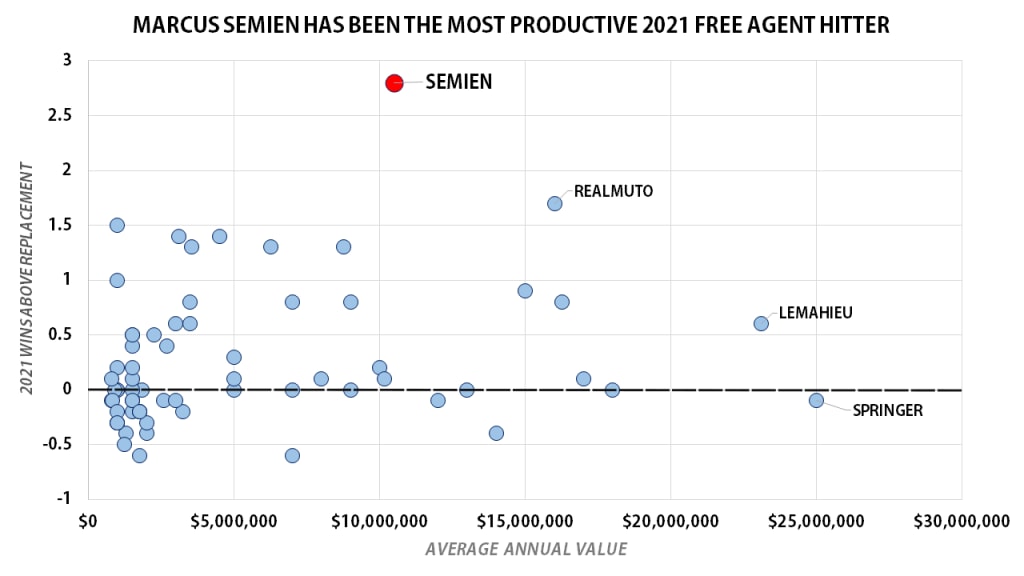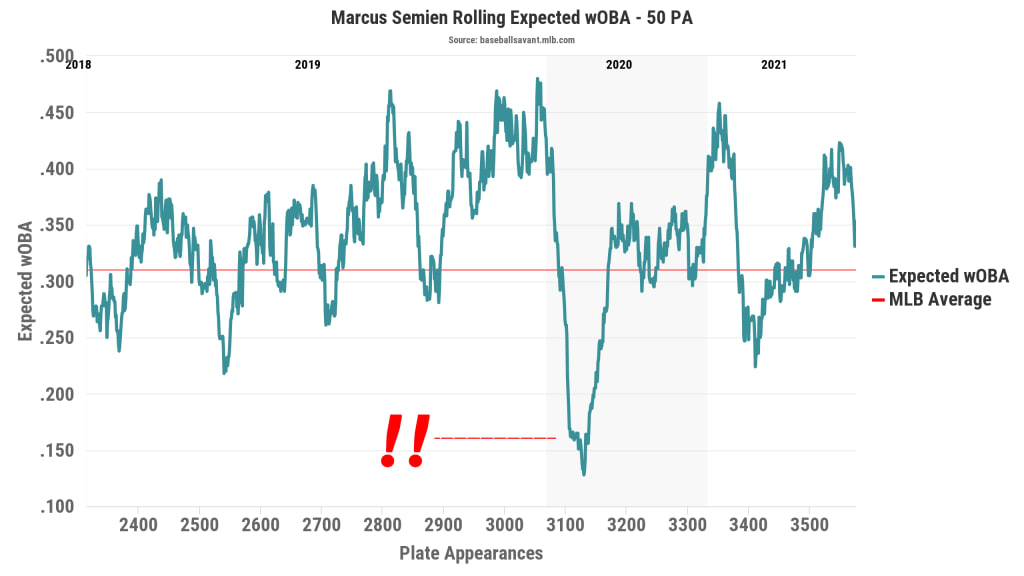Two years ago, Marcus Semien, who had been more decent than great over the first six seasons of his career with the White Sox and A’s, had a spectacular breakout year. In 2019, Semien smashed 33 homers, posted a 140 OPS+, continued to improve his previously unimpressive shortstop defense and finished third in American League Most Valuable Player voting.
At 28, it was difficult to tell if it was a fluke-ish career year or a true progression into something more, and a disappointing follow-up in the shortened 2020 season (sort of … we’ll get back to that) in which he hit a mere .223/.305/.374 (90 OPS+) didn’t exactly do a lot to enhance the idea that he’d made true, meaningful changes.
So instead of signing the big, long-term contract he’d likely have commanded had he reached free agency after 2019, Semien settled for a one-year, $18 million deal to play a position he hadn’t played in years (second base) for a team without a home (the Blue Jays). Seventeen players signed for more guaranteed money than he did -- not surprisingly, given his inconsistent track record.
Through the first one-third of the 2021 season, Semien is hitting .301/.372/.546 for the Blue Jays, a 153 OPS+. He’s been the second-best hitter on the club behind only the incandescent breakout of Vladimir Guerrero Jr., after having the best month of his career in May. As a hitter, he’s been one of the top 15 overall in the Majors; as a fielder, after years of Statcast metrics not backing up the narrative, he’s one of the best at his new position; overall, he’s been the best second baseman in the game.
All this despite a slow start and a noted dislike for the team’s temporary stint calling Dunedin, Fla., home. Though the Blue Jays are in fourth place, they're also four games over .500 and just five games out of first in the tough AL East. They wouldn't be there without Semien.
The best free-agent hitter to date
So how good does this signing look? Let’s focus on the position players, because several of last winter’s free-agent pitchers -- including Kevin Gausman and Marcus Stroman (who each accepted qualifying offers before reaching the market), as well as Trevor Bauer, Taijuan Walker, Liam Hendriks and Semien’s teammate Robbie Ray -- have also been variously good to great this year.
But it’s a different story for the position players. There were 66 of them who signed Major League contracts of at least $800,000, and it’s been a mixed bag. George Springer, who also signed with the Blue Jays, has played in just four games due to a quad injury. DJ LeMahieu, who returned to the Yankees, has seen his OPS drop by nearly 350 points. Outfielders Jackie Bradley Jr., Brett Gardner, Joc Pederson and Eddie Rosario are all performing below career norms.
It’s not all bad, of course. A few veterans who returned to their former homes (Justin Turner, J.T. Realmuto, Nelson Cruz, Michael Brantley, Mike Zunino) have been quite productive. Carlos Santana has had a nice rebound for Kansas City off a poor 2020 in Cleveland.
But none of them, for any salary, has offered what Semien has. A majority of them aren’t being paid much and aren’t providing much, all clustered around the 0-1 WAR range. Several are being paid more and offering less. There, at the top of the WAR leaderboards of last winter's position player class, stands Semien.

Will this last? Part of it was predictable, anyway, that he’d be fine at second base, given that he’d handled hundreds of balls at the position thanks to being a shifted shortstop with the A’s. Interestingly, a breakdown of his 2021 defensive positioning shows that he’s been +5 Outs Above Average on the right side of the infield, and -1 on the left -- perhaps suggesting that his long-term best fit is as a second baseman even on a team that doesn’t have Bo Bichette.
The down 2020 that wasn’t
But if the fielding isn’t a surprise, the batting might be. After all, Semien was a below-average hitter last year (90 OPS+), wasn’t he? Sure. Unless he wasn’t.
As we wrote in January, we broke the rules for a season that already failed to abide by any rules, pointing out that while you usually wouldn’t want to look at combined regular season and postseason stats (since generally that’s just a handful of extra plate appearances on top of the 650 or so you’d get over six months), nothing about 2020 was usual. We’re not just talking about the shortened season, either; the expanded postseason meant players like Jose Altuve had 22% of his 2020 plate appearances in October, rather than the usual 4% or so.
In Semien’s case, because he was so good in his extra week of games -- 11 hits and a 1.151 OPS against the White Sox and Astros -- it single-handedly boosted his 2020 from below-average to 7% above average, and wouldn’t that have looked different on his stat line headed into free agency?
There’s more to it, anyway. We know that Semien wasn’t healthy for most of 2020; he told us all explicitly, saying in September that his “strength wasn’t there” and he “didn’t feel great.” While that may be true, it’s more about how his season unfolded, as a slow start (.179/.207/.232 in his first 13 games, or nearly a quarter of his season) torpedoed his final line.
Or, maybe, just look at this:

That’s showing a rolling version of a Statcast metric that expresses production based more on quality of contact and amount of contact more than it does actual outcomes; the math behind here is less important than the simple visual action of oh no, look at that brief horrible dip that did not last. (It did not last.)
All of which makes 2021 …
… a good start, anyway, with a somewhat uncertain future.
Semien has had an enormous increase in his hard-hit rate, from 29% to 44%, which is actually the second-highest jump in the Majors, but is also out of line with anything he’d ever done before (his previous career high being 2019’s 38%). His quality of contact is similar to Bichette or Randal Grichuk’s, each having fine seasons, but he’s got the second-highest overperformance of that quality of contact, indicating perhaps his actual stat line is not reflecting what he’s actually doing.
The rest of it, well, it depends on what kind of ballplayer you like. You might look at the fact that he’s striking out nearly twice as much as he did in 2019 (25% now, after 14% then) as a huge warning sign; on the other hand, those kinds of hard-hit gains don’t come by accident, and are often paired with less contact. (Which is fine: he’s had a fantastic season. He actually struck out ever so slightly more in May, when he won AL Player of the Month, than he did in April, when he had a .658 OPS.)
The truth, as vanilla as this might sound, is that he’s somewhere in the middle, better than that .658 April OPS and not as good as that 1.130 May OPS. That’s not really the question, though. It’s “is he closer to the 2019 Semien than the 2020 Semien,” and the answer, so far, seems like yes, just in a different way, at a position that might be a better fit.
There were a few players you might have wanted to just write off 2020 entirely for, like Austin Meadows, who contracted COVID-19, injured his oblique, and now has an OBP/SLG that looks just like his excellent 2019. There were enough underlying reasons to explain Semien’s “down” season to have hope. The Blue Jays took the plunge. For a mere one-year deal, they’ve been rewarded with 2021’s best second baseman. Not a bad return on that investment.
